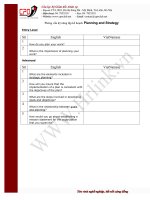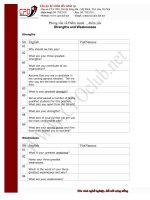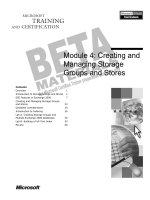Managing Retailing, Wholesaling, and Logistics doc
Bạn đang xem bản rút gọn của tài liệu. Xem và tải ngay bản đầy đủ của tài liệu tại đây (264.18 KB, 27 trang )
Managing Retailing,
Wholesaling, and Logistics
Marketing Management, 13
th
ed
16
Copyright © 2009 Pearson Education, Inc. Publishing as Prentice Hall
16-2
Chapter Questions
•
What major types of marketing intermediaries
occupy this sector?
•
What marketing decisions do these
marketing intermediaries make?
•
What are the major trends with marketing
intermediaries?
Copyright © 2009 Pearson Education, Inc. Publishing as Prentice Hall
16-3
What is Retailing?
Retailing includes all the activities involved
in selling goods or services directly to final
consumers for personal, nonbusiness use.
Copyright © 2009 Pearson Education, Inc. Publishing as Prentice Hall
16-4
Table 16.1 Major Retailer Types
•
Specialty store
•
Department store
•
Supermarket
•
Convenience store
•
Discount store
•
Off-price retailer
•
Superstore
•
Catalog showroom
Copyright © 2009 Pearson Education, Inc. Publishing as Prentice Hall
16-5
Levels of Retail Service
•
Self service
•
Self selection
•
Limited service
•
Full service
Copyright © 2009 Pearson Education, Inc. Publishing as Prentice Hall
16-6
Nonstore Retailing
•
Direct selling
•
Direct marketing
•
Automatic vending
•
Buying service
Copyright © 2009 Pearson Education, Inc. Publishing as Prentice Hall
16-7
Table 16.2 Major Types of Corporate
Retail Organizations
•
Corporate chain store
•
Voluntary chain
•
Retailer cooperative
•
Consumer cooperative
•
Franchise organization
•
Merchandising conglomerate
Copyright © 2009 Pearson Education, Inc. Publishing as Prentice Hall
16-8
What is a Franchising System?
A franchising system is a system of
individual franchisees, a tightly knit group of
enterprises whose systematic operations are
planned, directed, and controlled by the
operation’s franchisor.
Copyright © 2009 Pearson Education, Inc. Publishing as Prentice Hall
16-9
Characteristics of Franchises
•
The franchisor owns a trade or service mark
and licenses it to franchisees in return for
royalty payments
•
The franchisee pays for the right to be part of
the system
•
The franchisor provides its franchisees with a
system for doing business
Copyright © 2009 Pearson Education, Inc. Publishing as Prentice Hall
16-10
Changes in the
Retail Environment
•
New retail forms and combinations
•
Growth of intertype competition
•
Competition between store-based and non-
store-based retailing
•
Growth of giant retailers
•
Decline of middle market retailers
•
Growing investment in technology
•
Global profile of major retailers
Copyright © 2009 Pearson Education, Inc. Publishing as Prentice Hall
16-11
New Retail Forms and Combinations
•
Combination retailers
•
Pop-ups
•
Showcase stores
Copyright © 2009 Pearson Education, Inc. Publishing as Prentice Hall
16-12
Retailers’ Marketing Decisions
•
Target market
•
Product assortment
•
Procurement
•
Prices
•
Services
Copyright © 2009 Pearson Education, Inc. Publishing as Prentice Hall
16-13
Retailers’ Marketing Decisions (cont.)
•
Store atmosphere
•
Store activities
•
Communications
•
Locations
Copyright © 2009 Pearson Education, Inc. Publishing as Prentice Hall
16-14
Retail Category Management
•
Define the category
•
Figure out its role
•
Assess performance
•
Set goals
•
Choose the audience
•
Figure out tactics
•
Implement the plan
Copyright © 2009 Pearson Education, Inc. Publishing as Prentice Hall
16-15
Retailer Services Mix
•
Prepurchase services
•
Postpurchase services
•
Ancillary services
Copyright © 2009 Pearson Education, Inc. Publishing as Prentice Hall
16-16
Store Atmosphere
•
Walls
•
Lighting
•
Signage
•
Product placement
•
Floors
•
Surface space
•
Music
Copyright © 2009 Pearson Education, Inc. Publishing as Prentice Hall
16-17
Tips for Increasing Sales
in Retail Space
•
Keep shoppers in the store
•
Honor the transition zone
•
Don’t make them hunt
•
Make merchandise available to the reach and
touch
•
Note that men do not ask questions
•
Remember women need space
•
Make checkout easy
Copyright © 2009 Pearson Education, Inc. Publishing as Prentice Hall
16-18
Location Decision
•
Central business districts
•
Regional shopping centers
•
Community shopping centers
•
Shopping strips
•
Location within a larger store
Copyright © 2009 Pearson Education, Inc. Publishing as Prentice Hall
16-19
Indicators of Sales Effectiveness
•
Number of people passing by
•
Percent who enter store
•
Percent who buy
•
Average amount spent per sale
Copyright © 2009 Pearson Education, Inc. Publishing as Prentice Hall
16-20
Private Label Brands
•
Private labels are ubiquitous
•
Consumer accepts private labels
•
Private-label buyers come from all
socioeconomic strata
•
Private labels are not a recessionary
phenomenon
•
Consumer loyalty shifts from manufacturers
to retailers
Copyright © 2009 Pearson Education, Inc. Publishing as Prentice Hall
16-21
Wholesaling Functions
•
Selling and
promoting
•
Buying and
assortment building
•
Bulk breaking
•
Warehousing
•
Transportation
•
Financing
•
Risk bearing
•
Market information
•
Management
services and
counseling
Copyright © 2009 Pearson Education, Inc. Publishing as Prentice Hall
16-22
Major Wholesaler Types
•
Merchant
•
Full-service
•
Limited-service
•
Brokers and agents
•
Manufacturers
•
Specialized
Copyright © 2009 Pearson Education, Inc. Publishing as Prentice Hall
16-23
Market Logistics Planning
•
Deciding on the company’s value proposition
to its customers
•
Deciding on the best channel design and
network strategy
•
Developing operational excellence
•
Implementing the solution
Copyright © 2009 Pearson Education, Inc. Publishing as Prentice Hall
16-24
What are
Integrated Logistics Systems?
An integrated logistics system (ILS)
includes materials management, material
flow systems, and physical distribution, aided
by information technology.
Copyright © 2009 Pearson Education, Inc. Publishing as Prentice Hall
16-25
Market Logistics
•
Sales forecasting
•
Distribution
scheduling
•
Production plans
•
Finished-goods
inventory decisions
•
Packaging
•
In-plant
warehousing
•
Shipping-room
processing
•
Outbound
transportation
•
Field warehousing
•
Customer delivery
and servicing









